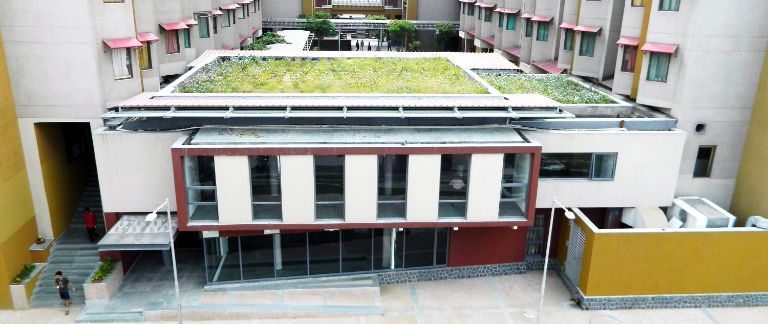Watch us in portrait mode to discover what makes us different.

The construction of a single building can have a ripple effect on the environment and its adjoining surroundings. The following facts are sobering.
NIIT University (NU) has been specifically designed with a focus on the impact it could cause to its surroundings. Since the first day when Founder Rajendra Singh Pawar vowed that not one hill on the campus land would be flattened, nor one truckload of earth be removed or brought in while building the university, NU has vowed to conserve energy and taken elaborate steps in order to reduce its carbon footprint.
Sustainable architecture and green building practices have been NU’s gameplan since day one. NU’s daylight harvesting system, for instance, ensures that natural resources are harnessed to offset energy needs.
Natural sunlight is harnessed to minimise the use of electric lighting to light the academic and living spaces throughout the university. This is achieved through different structural and mechanical mediations.
NU’s biggest contribution towards reducing its energy consumption is its Green Air-conditioning system which reduces energy consumption by over 50%. Since it is a fresh-air system, the Green Air-Conditioners not only keep residents cool, but also ensure that fresh, oxygen-rich air is circulated throughout the campus. “Our motto is, ‘Take a desert and convert it into a forest. Now bring the forest into your room’,” laughs Air Commodore Kamal Singh (Retd.), Advisor, Infra-services at NU. The 10-year-old system, while doing just that, has saved 50% energy costs as compared to a conventional air-conditioning system.
Other cooling efforts include the unique Earth-Air Tunnels (EAT) that draw the air into the bowel of the earth where the ambient temperature cools it; the cool air is then circulated through the buildings to keep the academic buildings and residences at a comfortable temperature. Geothermal coupling, air handling units and cooling towers which reuse water are other measures that the university takes to conserve resources and reduce its carbon footprint.
NU’s goal has always been to reduce, reuse and recycle. In transforming a desert landscape into a miniature oasis without impacting the environment in which it stands, the university has found ways to preserve, conserve and protect its natural resources. No wonder then that NU has consistently won awards for its green campus and its sustainability initiatives.